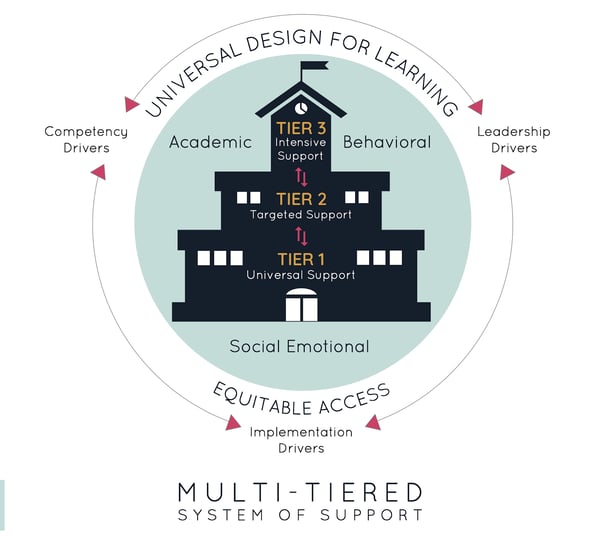Multi-tiered Systems of Support (MTSS), “Oh, that is just another name for Response To Intervention (RTI), right?” you say. Nope. Nadda. Sorry.
In order to meet the needs of all learners, we have to create inclusive and equitable systems that ensure that all students have equal opportunities to learn at high levels. We need to make sure students and educators are getting the support they need academically, behaviorally, and social-emotionally in order to succeed. To do this, we have to challenge beliefs, skills, and our systems so our work is learner-driven and evidence informed. All of that together, in a nutshell, is what forms a MTSS. But before we get into the nitty-gritty, let’s start with an analogy.
I drive a Suburban. It’s the perfect car when you have four kids who lug around giant lacrosse bags and a grumpy old dog. Now, I have very firm goals for my car – I need it to run smoothly and safely. So, I always make sure that I get my routine services.
Tier 1 at the mechanic involves an oil change, topping off fluids, a tire rotation, and a good ole’ vacuuming. While there, there are numerous universal screening measures to determine if additional services are needed. They check all the engine fluids, tire pressure, and windshield wipers and hook up machines that talk to the engine to see if there are any potential problems.
Sometimes, as a result of this screening, I need more services. We have all had the oil change appointment that quickly morphed into a radiator, transmission service or tire replacement. These are second level (Tier 2) services that we only need to get when those fancy assessment machines and mechanics share that we need them. What is important to note is that when Tier 2 services are necessary, I don’t lose out on Tier 1. The mechanic doesn’t say, “Sorry, Katie, but since you need your transmission serviced, you can’t get the oil changed.” Why? Because that would lead to more problems. In many cases, the same mechanic can perform both Tier 1 and Tier 2 services right at the same place. And I don’t have to get those Tier 2 services every time just because my car needed them now. Once the mechanics have shown that the additional services have done what they need to do, I am free to go back to just getting my oil change.

But let’s say the problems continue even after I had a transmission service. The car is jolting about when I get on the highway and makes a funny noise. I take my car in for a level 2 service again, but maybe that isn’t enough. Maybe I need more support. Let’s say I need a whole new transmission. Again, that doesn’t mean I don’t get my oil changed! This procedure might be classified as a level three service (Tier 3) and even fewer people need those services – but when you need them, I guarantee you will be thrilled they are available. As the level of service goes up, the repair is more intensive and progress monitoring is critical. Sometimes, the level 3 service might be out of the wheelhouse (see what I did there?!) of the mechanic and you’ll need to bring your car elsewhere, but some will be able to handle it just fine.
Are you still with me? And does that sound like RTI? Well, yes, it does because these tiered interventions do operate similarly to RTI, but they are only at the core of an MTSS – they aren’t the whole of it.
Essentially, when your car needs services, you should be able to get those services. And the same is true in our schools. When we have an MTSS, our schools offer multiple levels of support to students, when they need it. Higher levels of service don’t replace the “maintenance” (general education) services. It’s about supplementing, not supplanting Tier 1.
According to the MTSS Blueprint of the Massachusetts Department of Education, MTSS is a system designed to meet the needs of all students by ensuring that schools optimize data-driven decision making, progress monitoring, and evidence-based supports and strategies with increasing intensity to sustain student growth academically, behaviorally, and social-emotionally. To realize this success, multi-tiered systems must be supported by leadership, implementation, and competency drivers to ensure that all district resources are focused on supporting our students, who can and will learn and succeed with our support.
MTSS are recommended in the Every Student Succeeds Act (ESSA) as a “comprehensive continuum of evidence-based, systemic practices to support a rapid response to students’ needs, with regular observation to facilitate data-based instructional decision making.” At its heart, according to the Council of Great City Schools, “MTSS is a self-repeating, self-correcting, ongoing methodology for effective decision making at all levels of the system and across all three tiers”.

The visual above provides a representation of an MTSS model that is proactively built from the outside in (Novak, Massachusetts Department of Elementary and Secondary Education, 2020). All learners receive Tier 1, where they have opportunities to access grade-level rigor and behavioral and social-emotional support. In order for this to work, we need to build the skill level of educators, the vision of leadership and have the necessary tools to support students (i.e, the drivers).
If we zoom back to the mechanic analogy, an auto shop needs skilled mechanics, who can work with multiple makes and models, and who have numerous tools to diagnose issues and address them immediately so our cars are back on the road. They also need fluids, tools, and an auto-lift. We can’t expect mechanics to fix our car if they don’t have the right tools. And lastly, who are the leaders who are committed to ensuring high-quality customer satisfaction, ongoing communication, and a vision for success? How much more difficult would it be to get our cars fixed if say, the hours of operation were only 2-5 AM? That system doesn’t support improvement for many.
Tier 1 is universal support
It is the foundation of the system and is equitable and all-inclusive. All students will receive tier 1 support as they walk into the “front door” of the school as the visual suggests. Students will receive more support as necessary for their individual needs when data suggests it is necessary.
Tier 2 is for targeted support
Tier 2 is in addition to tier 1 and it is not “instead of” support. Tier 2 services may or may not supplement special education services for students with an IEP, depending on the individual student’s needs. The arrows to tier 2 and 3 represent “elevators”, and students may move up and down the tiers as data suggests they would benefit from more targeted and intensive support. For example, a student with an IEP for reading comprehension may receive tier 2 targeted supports for math. Another student with an IEP might receive tier 3 intensive supports for behavior and tier 1 universal supports for academics.
Tier 3 is for intensive support
These are often explicit, skills-based, focused interventions that occur individually or in very small groups. Again, tier 3 supports are provided for all students who need them. Tier 3 is not synonymous with special education. Students who receive tier 3 supports may remain in the same physical location as students only receiving tier 1 or tier 2 or both supports.
Why do we need MTSS?
We need MTSS in our schools so that we can minimize or eliminate barriers and improve student outcomes by designing equitable, tiered, universally designed systems of support that address student’s academic, behavioral, and social-emotional needs in ways that are culturally sustaining. It is a system for educating all of our students and educating them completely as a “whole” person.
If we can provide the services we need for our cars, we sure as heck can create systems that provide those supports, when they are needed, to our kids.
Keep Learning
If you need assistance with implementing a multi-tiered system of support, we’re here to help. Learn more about our professional development and long-term implementation assistance programs here.
Take action to transform systems and improve the outcomes of learners; register for the online course Building Success with MTSS.
Resources:
- https://keystoliteracy.com/blog/what-is-mtss/
- www.illuminateed.com/blog/2020/01/what-is-mtss/
- http://www.doe.mass.edu/sfss/mtss/
- https://www.cgcs.org/cms/lib/DC00001581/Centricity/Domain/87/77–Achievement%20Task%20Force–RTI%20White%20Paper-Final.pdf
This post has been updated from it's original publishing date (2021).



